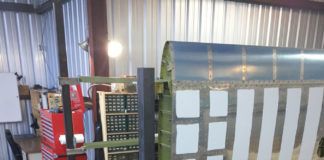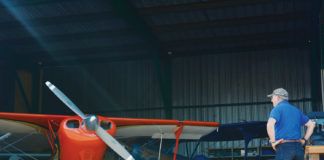We’re pleased to bring you a story we’ve been following since last autumn, the saga of restoring the original Van’s RV prototype. Purely by coincidence, the airplane was discovered last year, and it was in a profound state of neglect. Negotiations ensued, and eventually the airplane was acquired and the restoration began. A team of dedicated volunteers, collectively known as Friends of the RV-1, and a host of aviation suppliers chipped in to make the project possible. Early this year, remarkably, the airplane was back in flying condition and ready to be presented to the public.
While this may not seem momentous in itself, for RV builders and enthusiasts finding the RV-1 was like locating the origin of the Nile, the source from which all flowed. And the volunteers’ success is a triumph all in the homebuilding world can celebrate. Their efforts show not only a deep respect for the history of the design and the preservation of a piece of Experimental aircraft history, but it also illustrates what can be accomplished when members of a community put their hearts and minds into something and work toward a common goal. I hope you enjoy reading about their efforts.
Electric Aircraft Symposium
The annual Electric Aircraft Symposium, hosted by Brien Seeley and the CAFE Foundation and held in Santa Rosa, California in April, is another opportunity to celebrate successes in aviation, though its presenters and attendees are looking forward to the possibility of using alternative sources of energy rather than to preserving the past. Perhaps that’s why in only six years this symposium has grown from just three presenters and a modest turnout to 25 presenters and some 150 attendees for the day-and-a-half-long event.
The slate of speakers at EAS was ambitious and eclectic, and they covered topics ranging from unmanned aerial vehicles (UAVs) to motor controllers to pancake wheel motors to electric air taxis. Some of the stories of achievement were nothing short of remarkable and showed incredible moxie. Tine Tomazic of the Pipistrel Taurus G4 project that won last year’s Green Flight Challenge gave an account of how his team essentially started with an idea and in very short order created the highly efficient, award-winning aircraft we’ve all read about.
One aspect that was especially encouraging was the “open source” approach to collaboration that some of the presenters called for. In a spirit of cooperation rather than competition, they were willing to put their development efforts out there in the world for others to build on, which surely promises growth and opportunity for advancement of the research.
Seeley and the CAFE Foundation have ambitious plans for the Green Flight Challenges to come, likening them to the Apollo moonshot effort and rewarding them with a series of prizes. He envisions progressive challenges that will tackle specific elements of a vehicle, with prizes based on how hard each individual task is to achieve. These may include wheeled motors for takeoff, ultra-quiet propulsion, directed autonomous flight and fast E-STOL, with the series of challenges culminating in an actual suburban air vehicle (SAV) that could take advantage of “pocket airports” and provide efficient air taxi services to the general population at a reasonable price. This is ambitious, no doubt, but Seeley believes that if the prize is right, innovators will step up to the plate.
As Alternative Energies columnist Dean Sigler has been chronicling in his column, this future will entail more than just the air vehicles that will transport folks with reasonable speed and efficiency. It will require a wholesale change in the transportation infrastructure to allow greater use of smaller airports by employing convenient flight scheduling, perhaps capitalizing on some of the social networking capabilities we see today.
The need for an innovative alternative to the current commercial air transportation system, and the energy sources that fuel it, is unlikely to diminish. This is why the Electric Aircraft Symposium is one of the more important aviation conferences. The cutting-edge developments being discussed at this event surely will “trickle down” to those of us who are pilots along with those of us who use the domestic transportation infrastructure, and they are already significantly affecting how law enforcement and government entities conduct their operations. These scientists and researchers are shaping the future of aviation, and it’s worth a visit to the EAS to find out how. In the meantime, if you want to learn more, follow their developments at www.cafefoundation.org.

![]()
Mary Bernard – The product of two parents with Lockheed Aerospace careers, Mary grew up with aviation, prompting her to pursue pilot training as an adult. Her father, a talented tool-and-die maker and planner, instilled in her an abiding interest in how things are built. For more than a decade, she has been a contributing writer and Managing Editor for KITPLANES®.




